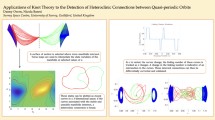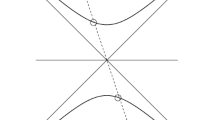Abstract
In this paper, we present a systematic study of the maximum number, denoted by H(m, n), of hyperelliptic limit cycles of the Liénard systems
where, respectively, \(f_m(x)\) and \(g_n(x)\) are real polynomials of degree m and n. The main results of the paper are as follows: We give the upper as well as the lower bounds of H(m, n) in all the cases. It turns out that in most cases these bounds are sharp. Furthermore, the configuration of hyperelliptic limit cycles is also explicitly described.


Similar content being viewed by others
References
Llibre, J.: A survey on the limit cycles of the generalization polynomial Liénard differential equations. AIP Conf. Proc. 1124, 224–233 (2009)
Dumortier, F., Li, C.: On the uniqueness of limit cycles surrounding one or more singularities for Liénard equations. Nonlinearity 9, 1489–1500 (1996)
Odani, K.: The limit cycle of the van der Pol equation is not algebraic. J. Differ. Equ. 115, 146–82 (1995)
Chavarriga, J., Garcia, I.A., Llibre, J., Zoladek, H.: Invariant algebraic curves for the cubic Liénard system with linear damping. Bull. Sci. Math. 130, 428–441 (2006)
Zoladek, H.: Algebraic invariant curves for the Liénard equation. Trans. Am. Math. Soc. 350, 1681–1701 (1998)
Llibre, J., Zhang, X.: On the algebraic limit cycles of Liénard systems. Nonlinearity 21, 2011–2022 (2008)
Yu, X., Zhang, X.: The hyperelliptic limit cycles of the Liénard systems. J. Math. Anal. Appl. 376, 535–539 (2011)
Liu, C., Chen, G., Yang, J.: On the hyperelliptic limit cycles of Liénard systems. Nonlinearity 25, 1601–1611 (2012)
Yang, L., Hou, X., Zeng, Z.: A complete discrimination system for polynomials. Sci. China Ser. E 39, 628–646 (1996)
Yang, L., Zhang, J., Hou, X.: Nonlinear Algebraic Equation System and Automated Theorem Proving. Shanghai Scientific and Technological Education Publishing House, Shanghai (1996)
Jouanolou, J.P.: Equations de Pfaff algébriques, Lectures Notes in Mathematics, vol. 708. Springer, Berlin (1979)
Acknowledgements
The paper is supported by the NSFC of China 11671016 and 11471027.
Author information
Authors and Affiliations
Corresponding author
Additional information
Publisher's Note
Springer Nature remains neutral with regard to jurisdictional claims in published maps and institutional affiliations.
Appendix A
Appendix A
In this appendix, we shall introduce a useful theorem for determining the number of the distinct real roots of a polynomial. See for instance [9, 10] for more details.
We shall first give some notations. Recall that \(D_k\) denoted the determinant of the submatrix of Discr(f), formed by the first 2k rows and the first 2k columns, for \(k=1,\ldots ,n\). Then the n-tuple \((D_1,D_2,\ldots ,D_n)\) is called the discriminant sequence of polynomial f(x). The sign of \(D_i\), with \(1\le i\le n\), is what interests us. Then we give the following definitions.
Definition 1
(Sign list) We call the list
the sign list of the discrimination sequence \((D_1,D_2,\ldots ,D_n)\).
Definition 2
(Revised sign list) Given a sign list \([s_1,s_2,\ldots ,s_n]\), we construct a new list \([\varepsilon _1,\varepsilon _2,\ldots ,\varepsilon _n]\) as follows:
If \([s_i,s_{i+1},\ldots ,s_{i+j}] =[s_i,0,0,\ldots ,0, s_{i+j}]\), i.e.,
$$\begin{aligned} s_i\ne 0,\quad s_{i+1}=\cdots =s_{i+j-1}=0, \quad s_{i+j}\ne 0, \end{aligned}$$(17)then we define a new list by keeping the two ends unchanged and replacing all these 0’s respectively by \(-s_i,-s_i,s_i,s_i, -s_i,-s_i,\ldots , (-1)^{\left[ \frac{j}{2}\right] }s_i\), i.e.,
$$\begin{aligned}{}[s_i,0,0,\ldots ,0,s_{i+j}] \rightarrow [s_i, -s_i,-s_i,s_i,s_i, -s_i,-s_i,\ldots , (-1)^{\left[ \frac{j}{2}\right] }s_i, s_{i+j}]. \end{aligned}$$If the subsection \([s_i,s_{i+1},\ldots ,s_{i+j}]\) doesn’t meet the relation (17), then there are no changes for it.
The determination of the number of the sign changes of the revised sign list is the prerequisites for the use of the theorem. Once we obtain the number of the distinct roots of f(x), and the number of the sign changes of the revised sign list, we can have the number of the distinct real roots of f(x).
Theorem A.1
Given a polynomial f(x) with real coefficients, if the number of the sign changes of the revised sign list of
is v, then the number of the pairs of distinct conjugate imaginary roots of f(x) equals v. Furthermore, if the number of non-vanishing members of the revised sign list is l, then the number of the distinct real roots of f(x) equals \(\, l-2v\).
Rights and permissions
About this article
Cite this article
Qian, X., Yang, J. On the Number of Hyperelliptic Limit Cycles of Liénard Systems. Qual. Theory Dyn. Syst. 19, 43 (2020). https://doi.org/10.1007/s12346-020-00382-5
Received:
Accepted:
Published:
DOI: https://doi.org/10.1007/s12346-020-00382-5




